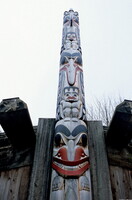| dc.coverage.spatial | Site: Museum of Anthropology at the University of British Columbia (Vancouver, British Columbia, Canada) | en_US |
| dc.coverage.temporal | ca. 1958-1962 (creation) | en_US |
| dc.creator | Reid, Bill | en_US |
| dc.date | 1958-1962 | en_US |
| dc.date.accessioned | 2013-01-16T14:53:01Z | |
| dc.date.available | 2013-01-16T14:53:01Z | |
| dc.date.issued | 1958-1962 | en_US |
| dc.identifier | 183944 | en_US |
| dc.identifier.other | archrefid: 1927 | en_US |
| dc.identifier.uri | http://hdl.handle.net/1721.3/91337 | |
| dc.description | Larger residential house, view of the central totem pole, looking up; The Haida House complex, located outside the Museum (and visible from the Great Hall), includes structures that would have been present in a nineteenth century Haida village. This complex includes a large family dwelling and a smaller mortuary house similar to those used traditionally to hold the dead. In front of the houses are examples of memorial and mortuary poles dating from 1951 to the present. The two Haida houses reconstructed on the grounds of the museum were probably the first of their kind to be built in the 20th century. Both demonstrate the traditional Haida post-and-beam architecture. These houses were designed by John Smyly and constructed by John Barnes of the University's Physical Plant, under the direction of Haida artist Bill Reid. The work took 3.5 years, from late 1958 to early 1962. The houses and poles were first installed at Totem Park on the west end of the University campus, and were relocated to the grounds of the Museum of Anthropology in 1978. The big house is equipped with a fire pit and lighting so that it can be used for workshops, receptions and theatrical performances. The house poles and three of the four free-standing Haida poles were carved between 1958-1962 by Bill Reid with the assistance of Douglas Cranmer of the Nimpkish Kwakwaka'wakw (Kwagiutl) band of Alert Bay. The fourth free standing pole, a copy of a Masset house frontal pole, was carved by Jim M. Hart, a Masset Haida, under Reid's guidance. It was completed and ceremonally installed in 1982. Source: Museum of Anthropology at the University of British Columbia [website]; http://www.moa.ubc.ca/ (accessed 5/17/2009) | en_US |
| dc.format.medium | wood (cedar); paint | en_US |
| dc.rights | © Scott Gilchrist, Archivision, Inc. | en_US |
| dc.subject | architectural exteriors | en_US |
| dc.subject | death or burial | en_US |
| dc.subject | Native North Americans | en_US |
| dc.subject | First Nations people | en_US |
| dc.subject | Native North American | en_US |
| dc.subject | Twentieth century | en_US |
| dc.subject | Haida | en_US |
| dc.title | Haida House Complex | en_US |
| dc.title.alternative | Haida House Complex, Museum of Anthropology at the University of British Columbia | en_US |
| dc.type | image | en_US |
| dc.rights.access | Licensed for educational and research use by the MIT community only | en_US |
| dc.identifier.vendorcode | 1A1-EA-MA-2-B3 | en_US |
| vra.culturalContext | Canadian Native American | en_US |
| vra.technique | carving (processes) construction (assembling) | en_US |
| vra.worktype | house | en_US |
| vra.worktype | mausoleum | en_US |
| dc.contributor.display | Bill Reid (Canadian consulting architect and sculptor, 1920-1998) | en_US |


